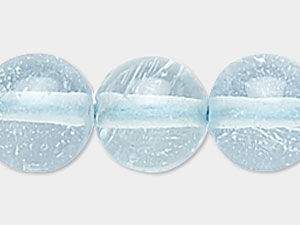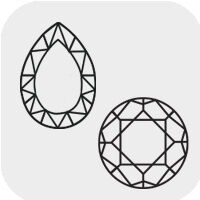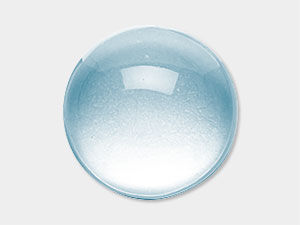Topaz, Blue Meaning and Properties
Blue Topaz History
Although most natural topaz is colorless, ancient lovers of gemstones assigned the name to almost any yellow and brown gemstone. The name itself likely comes from an island in the Red Sea, which the Greeks called Τοπάζιος (Topazios—it's now named Zabargad). The stone we modernly call "topaz" was never found on Topazos, but other gems—called "topaz" by ancient peoples without mineralogy—certainly were.
Topaz is one of the stones reportedly set in the breastplate of the Hebrew high priest. The ancient Greeks thought that topaz gave them strength. During the Middle Ages, people thought topaz could break magic spells.
Blue topaz is one of the accepted modern birthstones for December.
What are the Metaphysical Properties of Blue Topaz?
Topaz is considered a mellow, empathic stone that soothes, heals, recharges and re-centers its wearers. Associated with compassion and communication, it's a preferred stone to wear for "building bridges" between people. Blue topaz meaning, in particular, is associated with promoting truth and forgiveness, relaxing the spirit as well as the body. Those who use meditation advocate it as a splendid stone for attuning to their higher self.
Topaz of any color is often used to strengthen emotional support, stabilizing the emotions and making the wearer receptive to love from every source. It is believed to unburden the soul of arrogance and calmly verbalize in emotional situations. Blue topaz meaning is also linked to the calming nature of the skies and the sea.
What is Blue Topaz Made From?
Topaz is a hard stone with a range of natural colors, with some colors being more valuable. In fact, the value of some topaz is based on their depth of color, not their carat weight! This aluminum silicate stone contains up to 20% fluorine or water (which determines its color) and often grows into large crystals. The largest topaz, now in the Museum of Natural History in New York, weighs 10 pounds!
Blue topaz—created by flooding a colorless topaz with gamma rays—is tremendously popular. As long as the gemstone is clearly marked during sale, this is considered a legitimate practice. (All topaz in the U.S. must be tested for radiation levels—a precaution not required in other nations.) Topaz treated in this way is reminiscent of fine aquamarine, with a delicate blue color that occasionally displays a grey or green undertone.
Topaz is currently found in Brazil, Nigeria, Australia, Myanmar and Mexico.
|
|
|
|
|
|
|
|
|
|
|
|
|
|
|
|
|
|
How Do You Clean Blue Topaz?
Because it cleaves (splits) easily, topaz should never be cleaned in a steamer or ultrasonic cleaner. It should also be protected from sudden changes in temperature and from all acids. Keep blue topaz out of the sun, as the stone is easily bleached by heat and UV light.
Blue Topaz FAQ
Q: What is the birthstone month for blue topaz?
A: Blue topaz is a modern birthstone for the month of December.
Q: Is blue topaz rare?
A: Natural blue topaz is exceedingly rare.
Q: Is blue topaz treated or enhanced?
A: The blue hue of topaz is created through heating and irradiating colorless topaz.
Q: How does blue topaz compare to other blue gemstones like aquamarine or sapphire?
A: Many clear blue gemstones are available for jewelry designs. The following gives a brief overview of how they are like and different from blue topaz:

Blue Topaz: Mohs hardness of 8; glassy luster; available in a range of colors from light to dark blue

Aquamarine: Mohs hardness of 7-1/2 to 8; color spans from light blues to pale aqua greens—tends to be paler than blue topaz

Apatite: Mohs hardness of 5; exhibits a cat’s eye chatoyancy; tends to be more greenish than blue topaz

Kyanite: Mohs hardness of 4-1/2 to 7; tends to have streaks of color rather than the uniform hue of blue topaz, aquamarine and others

Sapphire: Mohs hardness of 9; tends to be more deeply colored than blue topaz

Blue Agate: Mohs hardness of 6-1/2 to 7; tends to be opaque or translucent rather than clear; some specimens have veining; color ranges from a soft blue to deep blue with a waxy sheen

Blue Cubic Zirconia: Mohs hardness of 8; manmade with several shades of blue available; high sheen with no inclusions
Designing with Blue Topaz
Blue topaz is the color of water, making it a wonderful substitute for the rarer and far more expensive aquamarine. No wonder this popular gemstone has been used for centuries in jewelry! Use it wherever you want the exquisite sense of crystal clear faintly blue water. It's a cool refreshing stone to use any time of year, but especially during summer. As an alternative birthstone for December, it can be used to replace or replicate blue zircon.
Shop for Blue Topaz
**Please note that all metaphysical or healing properties listed are collected from various sources. This information is offered as a service and not meant to treat medical conditions. Fire Mountain Gems and Beads® does not guarantee the validity of any of these statements.
How did you like this resource? Your feedback helps us provide resources that matter to you most.
Copyright Permissions
All works of authorship (articles, videos, tutorials and other creative works) are from the Fire Mountain Gems and Beads® Collection, and permission to copy is granted for non-commercial educational purposes only. All other reproduction requires written permission. For more information, please email copyrightpermission@firemtn.com.



